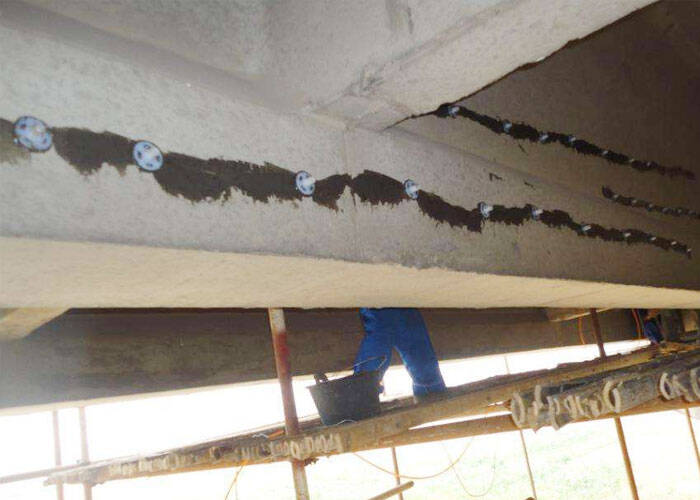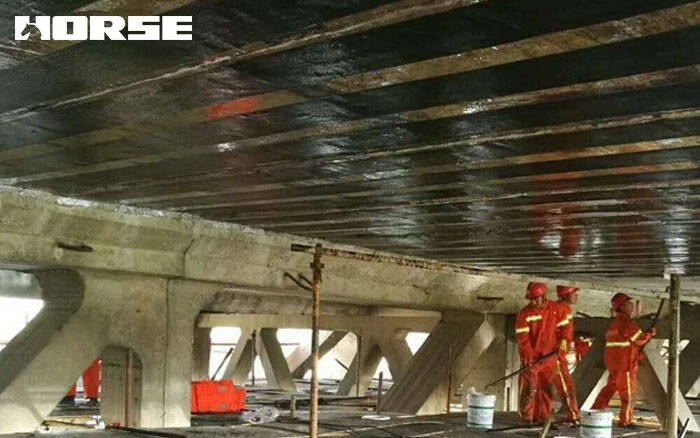Solutions
Horse Construction offers full range of structural strengthening materials with technical supports, documentation supports, products supports, project supports.
Carbon Fiber Reinforcement Technology In Bridge Crack Repair

Analysis of the characteristics of carbon fiber reinforcement technology
First, the construction process is simpler. The application of carbon fiber reinforcement technology to the treatment of bridge cracks can smoothly complete the repair construction without the use of large construction machinery and equipment. Carbon fiber material has good flexibility, construction personnel can combine specific construction needs, and orderly cut, the operation is more convenient, and the construction efficiency is high.
Second, the application performance is better. Carbon fiber materials have relatively stable chemical properties and will not react with acids and alkalis. Therefore, in the repair of bridge cracks, the use of carbon fiber reinforcement technology can reduce the occurrence of corrosion and reduce the repair cost of bridge engineering.
Third, the coefficient of thermal expansion is relatively small. The manufacturing process of carbon fiber materials is relatively special, and the coefficient of thermal expansion of carbon fiber materials is particularly small. The thermal expansion coefficient in the fiber direction can meet the requirements of construction specifications. This advantage is unsurpassed by other materials and can significantly improve the stability of the bridge.
Fourth, the intensity is relatively high. The strength of carbon fiber can reach 3800MPa, and the tensile strength far exceeds that of steel. And its elastic modulus is relatively close to steel.
Therefore, in the bridge reinforcement cracks, the use of carbon fiber materials for effective reinforcement can further improve the integrity of the bridge structure and increase the bearing capacity of the bridge structure.

Application of carbon fiber reinforcement technology in the process of repairing cracks in bridge engineering
Project Overview
A certain highway and bridge project has been in operation for a long time. In recent years, the road traffic in this area has increased rapidly, and there have been many cracks in the bridge deck pavement and the bottom of the bridge project. The upper structure of the bridge project is a reinforced concrete hollow slab structure, and the lower part adopts a pile-column pier.
Clean the surface of reinforced concrete components
For this bridge, the location of the cracks is focused on the pavement and the bottom of the beam. According to the damage of the bridge components and the construction requirements of the bridge project, the construction unit decided to use epoxy resin and carbon fiber cloth for reinforcement and repair. In the carbon fiber reinforcement construction plan, the construction personnel are required to install carbon cloth on the bottom of the hollow slab, and then paste the carbon fiber cloth strips at the joint position of the carbon fiber cloth.
If there are major defects on the surface of the bridge component, the construction personnel need to effectively clean the loose parts, implement anti-rust treatment on the exposed steel bars, and properly handle the concrete surface cracks. If the crack width of the concrete component is less than 0.2mm, epoxy resin can be used for smoothing treatment. If the crack width exceeds 0.2 mm, it can be repaired with epoxy resin.
Basic treatment points
(1) Constructors need to use mortar with a strength grade smaller than that of bridge components for effective repair. The surface of the concrete component is thoroughly cleaned, and the reinforced position of the concrete component must be polished. After the polishing treatment is completed, the surface of the concrete component is cleaned a second time to better improve the quality of carbon fiber bonding.
(2) Apply an appropriate amount of bottom interface agent. Apply an appropriate amount of epoxy resin to the surface of the bridge concrete components. After the epoxy resin penetrates into the interior of the concrete components, it will form a whole with the concrete components. The construction personnel should apply the interface agent in time.
Repair broken parts of concrete components
In the bridge crack repair link, if the surface of the bridge concrete member is still damaged after the bottom layer interface agent is applied, the construction personnel need to use epoxy putty for a second repair. After the repair is completed, sandpaper is needed to polish the fine particles on the surface of the bridge concrete components. Keep the surface of bridge concrete members clean, tidy and smooth.
Carbon fiber bonding on bridge
In the process of pasting carbon fiber, the construction personnel must use a special pasting tool. In order to ensure that the carbon fiber cloth can be completely saturated, before sticking, the resin glue should be evenly and fully coated on the carbon fiber cloth. Then paste it on the concrete member that has been painted, and there should be no air bubbles between the carbon fiber and the resin. The construction personnel can effectively squeeze the carbon fiber cloth along the fiber direction to squeeze out the air bubbles to ensure that the resin can better penetrate into the carbon fiber.
Concluding remarks
In summary, through the rational analysis of the use of carbon fiber reinforcement in the bridge joint repair process, such as cleaning the surface of concrete components, basic treatment points, repairing the defective parts of concrete components, carbon fiber bonding, and painting and curing of protective glue, It can ensure that carbon fiber reinforced bridge cracks are more used in repairing bridges. In this bridge crack repair construction, through the above measures, the bridge joint repair quality is effectively improved.
You can find anything here you are in need of, have a trust trying on these products, you will find the big difference after that.

High strength carbon fiber reinforced polymer (CFRP) strip / laminate / plate for structural strengthening and concrete repair

Prestressed carbon fiber reinforced polymer(CFRP) plate for slab, beam strengthening to increase stiffness, reduce distortion and deflection of members, reduce the cracks, avoid and stop cracking.

High strength, unidirectional carbon fiber sheet pre-saturated to form a carbon fiber reinforced polymer (CFRP) sheet used to strengthen structural concrete elements.